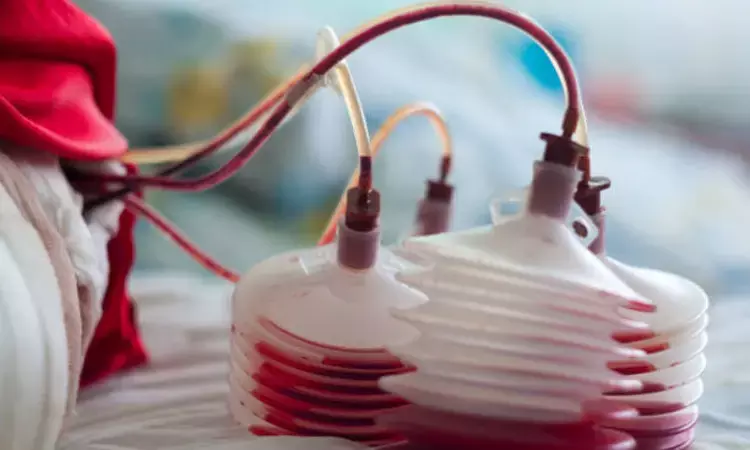- Home
- Medical news & Guidelines
- Anesthesiology
- Cardiology and CTVS
- Critical Care
- Dentistry
- Dermatology
- Diabetes and Endocrinology
- ENT
- Gastroenterology
- Medicine
- Nephrology
- Neurology
- Obstretics-Gynaecology
- Oncology
- Ophthalmology
- Orthopaedics
- Pediatrics-Neonatology
- Psychiatry
- Pulmonology
- Radiology
- Surgery
- Urology
- Laboratory Medicine
- Diet
- Nursing
- Paramedical
- Physiotherapy
- Health news
- Fact Check
- Bone Health Fact Check
- Brain Health Fact Check
- Cancer Related Fact Check
- Child Care Fact Check
- Dental and oral health fact check
- Diabetes and metabolic health fact check
- Diet and Nutrition Fact Check
- Eye and ENT Care Fact Check
- Fitness fact check
- Gut health fact check
- Heart health fact check
- Kidney health fact check
- Medical education fact check
- Men's health fact check
- Respiratory fact check
- Skin and hair care fact check
- Vaccine and Immunization fact check
- Women's health fact check
- AYUSH
- State News
- Andaman and Nicobar Islands
- Andhra Pradesh
- Arunachal Pradesh
- Assam
- Bihar
- Chandigarh
- Chattisgarh
- Dadra and Nagar Haveli
- Daman and Diu
- Delhi
- Goa
- Gujarat
- Haryana
- Himachal Pradesh
- Jammu & Kashmir
- Jharkhand
- Karnataka
- Kerala
- Ladakh
- Lakshadweep
- Madhya Pradesh
- Maharashtra
- Manipur
- Meghalaya
- Mizoram
- Nagaland
- Odisha
- Puducherry
- Punjab
- Rajasthan
- Sikkim
- Tamil Nadu
- Telangana
- Tripura
- Uttar Pradesh
- Uttrakhand
- West Bengal
- Medical Education
- Industry
Combined Intra articular and IV Tranexamic Acid more effective for controlling blood loss after THA

Tokushima, Japan: Masaru Nakamura et al found in a study that - the mean reduction in Hb was significantly smaller in the combination administration group than in the single dose group. However, no significant difference was observed due to the difference in the local dose of TXA administered at the time of wound closure.
Tranexamic acid (TXA) minimizes bleeding and the need for blood transfusion. However, no universal standard TXA dosing regimen has been established.
The authors retrospectively reviewed 292 hips. In all patients, surgery was performed using the same tech nique via a posterolateral approach in the lateral decubitus position. Cementless fxation was used for all implants. No drainage tube was inserted in the joint when the wound was closed to prevent the TXA solution inside the joint from draining to the outside.
Immediately before surgery, 1 g of TXA was administered IV for 226 hips (77.4%). Sixty-six patients (22.6%) at high risk for thromboembolic events did not receive IV TXA preoperatively. TXA was administered IA at the time of wound closure in all cases; the dose was 1 g for 96 hips, 2 g for 24 hips, and 3 g for 106 hips.
The decrease in Hb level (diference between the preoperative value and the 7-day postoperative value) was used to estimate total perioperative blood loss. The mean perioperative reduction in Hb was compared between hips that received intravenous TXA preoperatively and intra articular TXA at wound closure (combination administration group) and those that received only intra-articular TXA (single dose group). It was also compared by different local doses of tranexamic acid.
The observations in the study were:
• The mean intraoperative blood loss was significantly less in the combination administration group than in the single dose group (308.7±121.1 mL vs 363.5±137.2 mL; P<0.001)
• The mean perioperative decrease in Hb also was significantly less in the combination administration group than in the single dose group (2.25±1.02 g/dL vs 2.49±0.96 g/dL; P=0.0468;)
• Regardless of the dose or frequency of TXA, no serious perioperative complications such as pulmonary thromboembolism, myocardial infarction, or cerebral infarction related to TXA administration were observed in either group during the perioperative period up to postoperative day 7.
• There was no significant difference between the groups in the presence of deep vein thrombosis on postoperative day 7 (P = 0.2087).
The authors concluded that - the finding of the study suggests that preoperative administration of IV TXA and an additional topical dose when closing the wound is more effective for controlling blood loss in these patients. Furthermore, with or without preoperative TXA administration, there was no significant difference due to the difference in the intra-articular dose of TXA administered at the time of wound closure regarding to the mean perioperative decrease in Hb levels. Further studies are needed to determine the optimal TXA dosing regimen.
Further reading:
Efectiveness of Primary Total Hip Arthroplasty Combined with Intra articular and Intravenous Tranexamic Acid: A Retrospective Analysis of Number of Doses and Dose Strength
Masaru Nakamura, Tateaki Shimakawa et al
Indian Journal of Orthopaedics (2022) 56:1234–1239
https://doi.org/10.1007/s43465-021-00595-z
MBBS, Dip. Ortho, DNB ortho, MNAMS
Dr Supreeth D R (MBBS, Dip. Ortho, DNB ortho, MNAMS) is a practicing orthopedician with interest in medical research and publishing articles. He completed MBBS from mysore medical college, dip ortho from Trivandrum medical college and sec. DNB from Manipal Hospital, Bengaluru. He has expirence of 7years in the field of orthopedics. He has presented scientific papers & posters in various state, national and international conferences. His interest in writing articles lead the way to join medical dialogues. He can be contacted at editorial@medicaldialogues.in.


